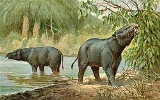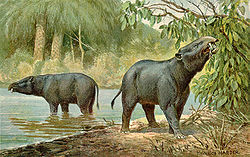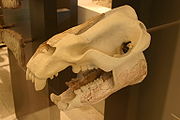
Moeritherium
Encyclopedia
Moeritherium is a genus
consisting of several species
. These prehistoric mammal
s are related to the elephant
and, more distantly, the sea cow. They lived during the Eocene
epoch.
The Moeritherium species were pig-like animals that lived about 37-35 million years ago, and resembled modern tapir
s or pygmy hippopotamus
es (they are not believed to be related to any of these animals, however). They were smaller than modern elephants, standing only 70 centimetres (2.3 ft) high at the shoulder and were about 3 metres (9.8 ft) long. They are believed to have wallowed in swamps and rivers, filling the ecological niche
now filled by the hippopotamus
. The shape of their teeth suggest that they ate soft water vegetation.
The shape of the skull suggests that Moeritherium did not have an elephant-like trunk, but it may have had a broad flexible upper lip like a tapir
's for grasping aquatic vegetation. The second incisor
teeth formed small tusks, although these would have looked more like the teeth of a hippo than a modern elephant
.

 In 1901, Charles William Andrews
In 1901, Charles William Andrews
described Moeritherium lyonsi from fossil remains found in the Qasr-el-Sagha formation
in the Al Fayyum
in Egypt
. Andrews described Moeritherium gracile from fossil remains of a smaller specimen found in the same area in 1902 in a fluvio-marine formation, that is a river estuary wetlands to brackish lagoon paleoenvironment
. In 1904, the first Moeritherium trigodon fossils were discovered by Charles Andrews in the deposit
s of an oasis in Al Fayyum. It is also found in other sites around North and West Africa. In 1911, Max Schlosser
of Munich divided Moeritherium lyonsi into two species: Moeritherium lyonsi, a large form from the Qasr-el-Sagha formation, and a new large species M. andrewsi from a fluvio-marine formation. In 2006, Moeritherium chehbeurameuri has been described from fossil remains found in the early late Eocene locality of Bir El Ater, Algeria
.
, looked relatively similar to modern elephants. However, Moeritherium typified a branch of the family that evolved
in a quite different way, having only a stubby trunk and short legs.
Genus
In biology, a genus is a low-level taxonomic rank used in the biological classification of living and fossil organisms, which is an example of definition by genus and differentia...
consisting of several species
Species
In biology, a species is one of the basic units of biological classification and a taxonomic rank. A species is often defined as a group of organisms capable of interbreeding and producing fertile offspring. While in many cases this definition is adequate, more precise or differing measures are...
. These prehistoric mammal
Mammal
Mammals are members of a class of air-breathing vertebrate animals characterised by the possession of endothermy, hair, three middle ear bones, and mammary glands functional in mothers with young...
s are related to the elephant
Elephant
Elephants are large land mammals in two extant genera of the family Elephantidae: Elephas and Loxodonta, with the third genus Mammuthus extinct...
and, more distantly, the sea cow. They lived during the Eocene
Eocene
The Eocene Epoch, lasting from about 56 to 34 million years ago , is a major division of the geologic timescale and the second epoch of the Paleogene Period in the Cenozoic Era. The Eocene spans the time from the end of the Palaeocene Epoch to the beginning of the Oligocene Epoch. The start of the...
epoch.
The Moeritherium species were pig-like animals that lived about 37-35 million years ago, and resembled modern tapir
Tapir
A Tapir is a large browsing mammal, similar in shape to a pig, with a short, prehensile snout. Tapirs inhabit jungle and forest regions of South America, Central America, and Southeast Asia. There are four species of Tapirs: the Brazilian Tapir, the Malayan Tapir, Baird's Tapir and the Mountain...
s or pygmy hippopotamus
Pygmy Hippopotamus
The pygmy hippopotamus is a large mammal native to the forests and swamps of western Africa . The pygmy hippo is reclusive and nocturnal...
es (they are not believed to be related to any of these animals, however). They were smaller than modern elephants, standing only 70 centimetres (2.3 ft) high at the shoulder and were about 3 metres (9.8 ft) long. They are believed to have wallowed in swamps and rivers, filling the ecological niche
Ecological niche
In ecology, a niche is a term describing the relational position of a species or population in its ecosystem to each other; e.g. a dolphin could potentially be in another ecological niche from one that travels in a different pod if the members of these pods utilize significantly different food...
now filled by the hippopotamus
Hippopotamus
The hippopotamus , or hippo, from the ancient Greek for "river horse" , is a large, mostly herbivorous mammal in sub-Saharan Africa, and one of only two extant species in the family Hippopotamidae After the elephant and rhinoceros, the hippopotamus is the third largest land mammal and the heaviest...
. The shape of their teeth suggest that they ate soft water vegetation.
The shape of the skull suggests that Moeritherium did not have an elephant-like trunk, but it may have had a broad flexible upper lip like a tapir
Tapir
A Tapir is a large browsing mammal, similar in shape to a pig, with a short, prehensile snout. Tapirs inhabit jungle and forest regions of South America, Central America, and Southeast Asia. There are four species of Tapirs: the Brazilian Tapir, the Malayan Tapir, Baird's Tapir and the Mountain...
's for grasping aquatic vegetation. The second incisor
Incisor
Incisors are the first kind of tooth in heterodont mammals. They are located in the premaxilla above and mandible below.-Function:...
teeth formed small tusks, although these would have looked more like the teeth of a hippo than a modern elephant
.
Fossil remains


Charles William Andrews
Charles William Andrews F.R.S., was a British palaeontologist whose career as a vertebrate paleontologist, both as a curator and in the field, was spent in the services of the British Museum, Department of Geology.-Biography:...
described Moeritherium lyonsi from fossil remains found in the Qasr-el-Sagha formation
Geologic formation
A formation or geological formation is the fundamental unit of lithostratigraphy. A formation consists of a certain number of rock strata that have a comparable lithology, facies or other similar properties...
in the Al Fayyum
Al Fayyum
Faiyum is a city in Middle Egypt. Located 130 km southwest of Cairo, it is the capital of the modern Faiyum Governorate. The town occupies part of the ancient site of Crocodilopolis...
in Egypt
Egypt
Egypt , officially the Arab Republic of Egypt, Arabic: , is a country mainly in North Africa, with the Sinai Peninsula forming a land bridge in Southwest Asia. Egypt is thus a transcontinental country, and a major power in Africa, the Mediterranean Basin, the Middle East and the Muslim world...
. Andrews described Moeritherium gracile from fossil remains of a smaller specimen found in the same area in 1902 in a fluvio-marine formation, that is a river estuary wetlands to brackish lagoon paleoenvironment
Paleoecology
Paleoecology uses data from fossils and subfossils to reconstruct the ecosystems of the past. It involves the study of fossil organisms and their associated remains, including their life cycle, living interactions, natural environment, and manner of death and burial to reconstruct the...
. In 1904, the first Moeritherium trigodon fossils were discovered by Charles Andrews in the deposit
Stratum
In geology and related fields, a stratum is a layer of sedimentary rock or soil with internally consistent characteristics that distinguish it from other layers...
s of an oasis in Al Fayyum. It is also found in other sites around North and West Africa. In 1911, Max Schlosser
Max Schlosser
Max Schlosser was a German zoologist and paleontologist. He is best known for his research about extinct primates and Caniformia.-External links:* from Scribd...
of Munich divided Moeritherium lyonsi into two species: Moeritherium lyonsi, a large form from the Qasr-el-Sagha formation, and a new large species M. andrewsi from a fluvio-marine formation. In 2006, Moeritherium chehbeurameuri has been described from fossil remains found in the early late Eocene locality of Bir El Ater, Algeria
Algeria
Algeria , officially the People's Democratic Republic of Algeria , also formally referred to as the Democratic and Popular Republic of Algeria, is a country in the Maghreb region of Northwest Africa with Algiers as its capital.In terms of land area, it is the largest country in Africa and the Arab...
.
Extinct branch
Moeritherium is not believed to be an ancestor of modern elephants; it was a branch of the order that died out, leaving no descendants. There were several species of early elephants in existence during the Eocene, and some, such as PalaeomastodonPalaeomastodon
Palaeomastodon an extinct genus of Proboscidea. Palaeomastodon fossils have been found in Africa, lived some 36-35 million years ago. They are believed to be the ancestors of elephants or mastodons. This genus is related to Moeritherium....
, looked relatively similar to modern elephants. However, Moeritherium typified a branch of the family that evolved
Evolution
Evolution is any change across successive generations in the heritable characteristics of biological populations. Evolutionary processes give rise to diversity at every level of biological organisation, including species, individual organisms and molecules such as DNA and proteins.Life on Earth...
in a quite different way, having only a stubby trunk and short legs.
In popular culture
- Moeritherium appears in Walking with BeastsWalking with BeastsWalking with Beasts is a 2001 six-part television documentary miniseries, produced by the BBC in the United Kingdom, narrated by Kenneth Branagh. In North America it has been retitled Walking with Prehistoric Beasts, and the original Discovery Channel broadcast was narrated by Stockard Channing...
where it was shown living like hippos and being prey for BasilosaurusBasilosaurusBasilosaurus is a genus of cetacean that lived from in the Late Eocene. Its fossilized remains were first discovered in the southern United States . The American fossils were initially believed to be some sort of reptile, hence the suffix -"saurus", but later found to be a marine mammal...
. It was also in Ice AgeIce Age (film)Ice Age is a 2002 American computer-animated film created by Blue Sky Studios and released by 20th Century Fox. It was directed by Carlos Saldanha and Chris Wedge from a story by Michael J. Wilson. The story follows three Paleolithical mammals attempting to return a lost human baby to its parents...
and Ice Age: The MeltdownIce Age: The MeltdownIce Age: The Meltdown, also known as Ice Age 2: The Meltdown or simply as Ice Age 2, is the 2006 sequel to the 2002 computer-animated film Ice Age. It was produced by Blue Sky Studios for 20th Century Fox, and premiered in Belgium on March 1, 2006...
.

